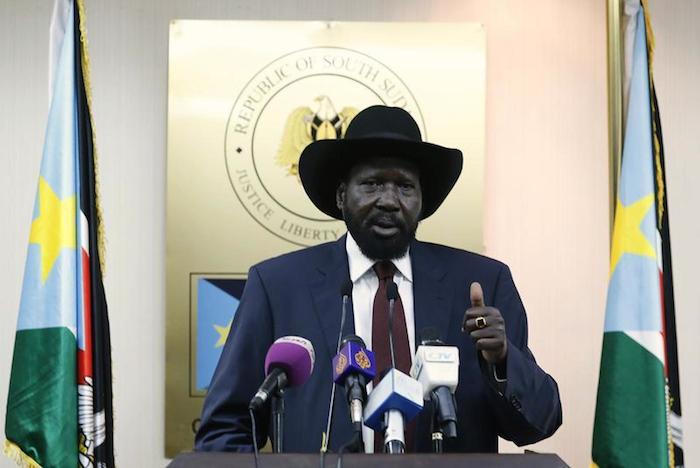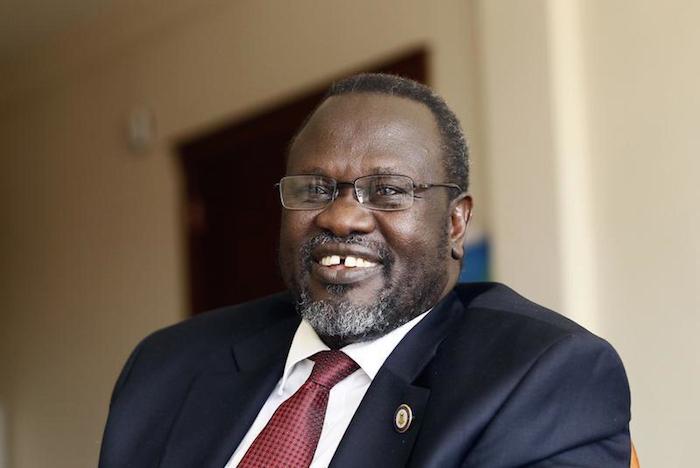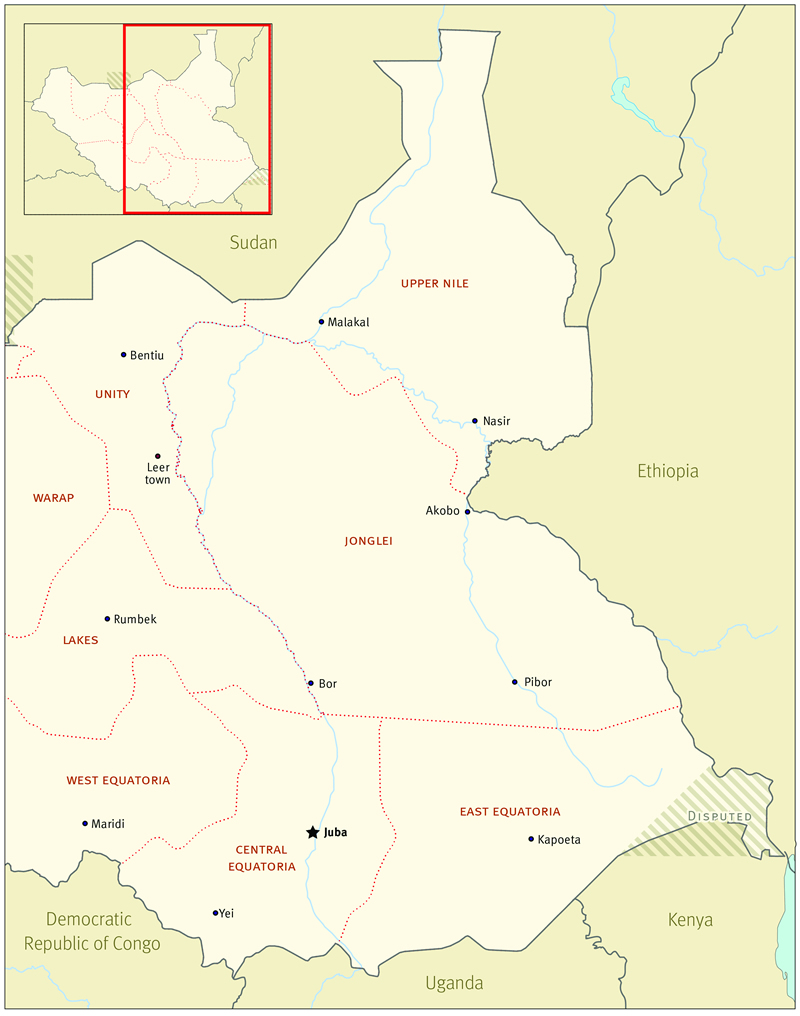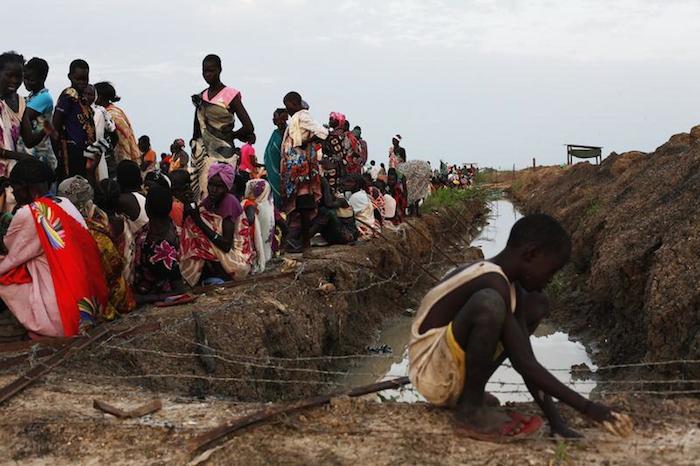It’s still not clear exactly what happened on December 15 in the Juba barracks of South Sudan’s presidential guard. The government claimed it was an attempted coup, but has struggled to provide any evidence. Others say soldiers loyal to President Salva Kiir Mayardit, a Dinka, disarmed soldiers loyal to the former vice president, Riek Machar, a Nuer. What we do know is that the presidential forces split – broadly down the lines of Dinka and Nuer, South Sudan’s two largest ethnic groups.
They fought furiously, plunging Juba, the capital, into violence. The conflict spread like wildfire, and two weeks later much of the eastern part of the country had unraveled into deadly fighting. Thousands of civilians have been killed, often because of their ethnicity, and an estimated 1.5 million have been displaced. Now, South Sudan faces a new imminent threat – famine. Researcher Skye Wheeler speaks with Amy Braunschweiger about her new report, how alleged war crimes have contributed to this humanitarian disaster, and how the lack of justice after South Sudan’s recent civil war brought us to where we are today.

South Sudan's President Salva Kiir gestures during a news conference in Juba December 18, 2013. Photo © 2013 REUTERS/Goran Tomasevic |

South Sudan's rebel leader Riek Machar attends an interview with Reuters in his office in Ethiopia's capital Addis Ababa July 9, 2014. Photo © 2014 REUTERS/Tiksa Negeri |
Fighting spread across South Sudan shockingly quickly. Was this planned?
Tensions between Kiir and Machar worsened in the months ahead of the conflict, and there have long been tensions between the two groups. South Sudan has been in on-and-off conflict for 60 years, with multiple generations brought up in violence and war. Dinka and Nuer killed each other horrible ways before the 21-year civil war ended in 2005.

One problem was that the 2005 peace agreement didn’t address war crimes and abuses during this conflict. There was no justice, and there was no national truth-telling process. Instead, everything simmered. Fear and anger never went away and ethnic loyalties were never replaced with a truly national identity.
I moved to Juba in 2005, and worked there for five years as a journalist. When you talked to Nuer or Dinka about what happened between them in the civil war, the conversation became strained and painful. Everyone knew it was a problem, but everyone wanted to carry on and forget about the past.
When South Sudan won independence in 2011, there was this real sense of things moving forward. But that’s not what happened.
It’s important to acknowledge the role of pain in the current conflict, of past trauma and violence and anger – how much people fear being attacked, and having what little they have taken away.
The presidential guard’s barracks, where the fighting started, was in the capital. What happened when the fighting spilled into the city?
Juba has maybe half a million people from all over South Sudan, but most of the soldiers in the town were Dinka and Nuer. When the gun battles began, government security forces, mostly Dinka, cracked down on Nuer civilians, too. Cars were stopped and Nuer men, identified by their traditional scarification marks or the names on their ID cards, were beaten, arrested, or shot. Some Dinka soldiers demanded that men speak in Dinka, and attacked them if they couldn’t. In some neighborhoods Dinka soldiers went from house to house, shooting or arresting Nuer. Sometimes if Nuer tried to run they’d be shot.
How do you research violence like this? How do you find out what really happened?
A big part of my job is to find witnesses or survivors and then cross check the cases. You talk to hundreds of people and patterns begin to emerge. First, you spread your net wide, and when you find a survivor you’re initially pleased because you’re getting your job done, but your heart also sinks because that means it’s real. As you talk to more survivors, you get more certainty, more clarity, which is important. But there’s a kind of shakiness in your body when you hear the same story for the sixth time, and you recognize details, and you know how it will end.
I spoke with seven survivors of the Juba Gudele massacre, one of the worst incidents in the conflict. One was a young Nuer man, a student, about 20, we can call him David. He was arrested by Dinka security forces, marched at gunpoint to Gudele and put inside a room in a building. Forces crammed 200 to 400 Nuer men in that room, he told me. They were squeezed together, and people collapsed from the heat. There wasn’t enough air. They kept trying to open the windows along one side of the room, but couldn't, he said.
Then, after it was dark, men outside put their guns through those windows and started shooting. The only light came from the machine gun, David said, and all he could hear was the endless shooting. He lived because other bodies fell on top of him. An hour later, men came into the room with torches, shone them on the bodies, and shot anyone who moved. David tried to stay still.
The forces left the door open when they left, and David ran into the night, his clothes covered in blood. He didn’t have any other clothes and had to stay in them for 24 hours before he reached a UN base and someone gave him a blue T-shirt. He was still wearing it when we talked. It was all he had.
When I asked him about the future, he told me that he had “no hope.” He wasn’t in tears, he wasn’t dramatic about it. It sounds like a generalization, but South Sudanese have a tough way of talking about violence. They’re angry. They also have very strong community networks. But David seemed devastated and lonely. He seemed broken.
In other areas of South Sudan, it was the Nuer killing Dinka.
In towns like Bor, where primarily Dinka live, there have been extreme levels of destruction and violence. Opposition forces purposefully killed many Dinka civilians.
I first went to Bor in January, after the opposition forces left. It’s a large town where most people live in mud huts, called tukuls. There were bodies dotted all over the town. In one church compound there were 11 decomposing bodies of women who had been shot. The smell was unbelievable. We had trouble finding a car because they had all been looted, as had NGO offices and homes.
The whole market had been burned down into a snarling mess of corrugated iron. The place was nearly deserted, and the people we met looked like ghosts, thin and subdued. Most of them had just returned from hiding, and they’d take us to where they’d found bodies. They’d open the door to a hut and say, “There she is,” motioning to their dead neighbor rotting under a blanket.
A few months later I returned to Bor, and they were still finding bodies.
During that trip, I met this man who showed me around his neighborhood. He told me how Nuer forces went through the village and shot at everyone they saw. In the hut across the road, he showed me a rotting head that had rolled underneath a bedframe – it had become detached when the authorities came to collect the body and they’d left it by mistake. A chief showed me body-shaped piles of ash, where villagers burned the bodies the authorities didn’t collect. He’d describe each ash pile, saying, “This old couple didn’t want to run.” Or he’d point to an oily imprint on the ground where a body had lain and say, “A lady civil servant was here” or “An old man was here.”
One woman I spoke with still had an oily mark on the ground inside her door frame where she’d found her dead brother-in-law. I wondered what is it like to go back home and have this body-shaped patch on the ground where your close relative was killed?
That’s awful.
I spoke with one elderly Dinka woman who really stayed in my mind. She had cropped white hair, and like many South Sudanese, she sat on the ground with her legs out in front of her, crossed at the ankles, and her back stick-straight. She was skinny, with old people’s feet, knees and elbows that were callused and bumpy from a hard life. She had just come to Bor town, to an empty hut, because her own village, Werkok was burned down. All the young people had been killed, she said, and she was tired and didn’t want to do it anymore.
The woman had almost nothing. She was boiling a little bit of water on a fire, and she had the lower half of a cow’s leg, from knee to hoof, to eat. I wondered how she she’d get sustenance from this bony cow’s leg. It stuck with me, this old, old grandma living on her own in a town where there are bodies everywhere. She was just unbelievably sad. My translator was a young man from the area. He was a musician, and like many young men here, he was a soldier and apparently unafraid of violence. When we walked away he said, “She’s finished now, she thinks too much.” It struck me that he thought her sadness was a result of her thinking too much.

© 2014 Reuters/Andreea Campeanu
There’s a very real possibility of a famine hitting South Sudan, because people fled and didn’t plant their fields during the fighting. What does this mean for the country?
The humanitarian situation is terrible. About 1.5 million people are displaced, and the despair is palpable. There are around 100,000 people on UN bases and they’re too scared to leave the protection of the peacekeepers. The rainy season has come, which makes it harder for aid to reach people. The UN Bentiu base shelters roughly 40,000 people living there in grass huts, and when it rains they stand mid-calf deep in water.
Human rights abuses have helped contribute to this humanitarian crisis and now this potential famine. At least 3.5 million people need food aid. It’s history repeating itself. In 1998, South Sudan – then still part of Sudan – had a terrible famine that was also a product of fighting and ensuing human rights violations. Fighting between Dinka and Nuer in the early 1990s also created areas of famine.
What do you want to see happen when both sides decide to put their weapons away?
There are peace talks under way in Addis Ababa, although it’s a peace process in word only, as neither side has come to the table. This process needs to be different from the one that led to the 2005 peace deal, and it needs to take the South Sudanese in a different direction. Perpetrators on both sides need to be held to account. As the South Sudanese judicial system does not have the capacity to deal with abuses on this scale, international expertise will be needed to help prosecute the worst crimes to international standards. This time there can be no sweeping amnesties. A broad, inclusive truth-telling process should also be established, in which victims are safe to speak and people in power must speak. These steps will be needed to help end both the human rights crisis and the humanitarian crisis in South Sudan.





